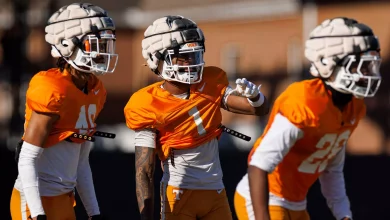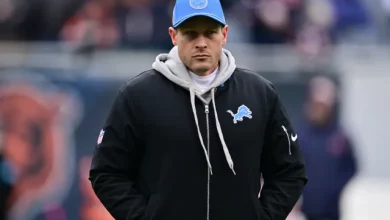Will Ethan Feaster, a five-star receiver recruit, commit to the Texas Longhorns or USC Trojans?

Ethan Feaster, a five-star wide receiver in the 2025 recruiting class, has emerged as one of the most sought-after recruits in college football. With his elite skill set, exceptional athleticism, and game-breaking ability, Feaster has become a priority for multiple top-tier programs across the country. Among the schools vying for his commitment are two of college football’s biggest powerhouses: the Texas Longhorns and the USC Trojans. Both programs have a rich football tradition, highly regarded coaching staffs, and have been successful in attracting top-tier talent in recent years. However, Feaster’s decision between these two prestigious programs will come down to a range of factors that could influence the trajectory of his college career.
As Feaster enters the final stages of his recruitment process, college football fans and analysts alike are eagerly awaiting his decision. Texas and USC each offer unique advantages, and both head coaches—Steve Sarkisian of Texas and Lincoln Riley of USC—have strong track records of developing wide receivers and building high-powered offenses. In this article, we will explore both programs, their respective coaching philosophies, and how each fits into Feaster’s aspirations as a player. Ultimately, Feaster’s decision will not only affect the future of his career but also impact the recruiting landscape at both schools for years to come.
Ethan Feaster: A Player with Limitless Potential
Before delving into the comparison between Texas and USC, it’s important to understand why Feaster has become one of the most coveted players in the 2025 class. Standing at 6’3″ and weighing 190 pounds, Feaster possesses an ideal combination of size, speed, and agility that makes him a nightmare matchup for opposing defenders. His ability to stretch the field with his deep routes, coupled with his quickness in short-space situations, has made him a dangerous weapon in both the passing game and as a red-zone threat.
Feaster’s highlight reel showcases a versatile skill set that includes high-pointing the ball on contested catches, making defenders miss in the open field, and displaying exceptional route-running precision. His ability to accelerate and separate from defenders after the catch is one of his most impressive attributes. Additionally, Feaster’s ability to track the ball in the air and make adjustments while in motion sets him apart from other wide receivers in his class.
Feaster’s football IQ is equally impressive, as he has demonstrated an understanding of the game beyond just physical ability. He reads defenses well, identifies mismatches, and uses his agility to exploit weaknesses. This combination of physical tools and mental acuity makes him a potential future star at the next level.
Given his talents, Feaster has already drawn interest from some of the most successful programs in college football. His recruitment has been intense, and both Texas and USC have put together strong pitches to secure his commitment. Let’s take a closer look at what each school offers and how they might factor into his decision-making process.
The Texas Longhorns: A Program on the Rise
The Texas Longhorns, under the leadership of head coach Steve Sarkisian, have seen a resurgence in recent years. After a couple of years of rebuilding, Sarkisian has turned Texas into a competitive program with championship aspirations. The Longhorns’ offense has been particularly impressive, with a balanced attack that utilizes both the passing game and the running game to great effect. As Texas has regained its stature as a college football power, Feaster’s potential role within their offense becomes increasingly attractive.
Steve Sarkisian’s Offensive Philosophy
Sarkisian, known for his offensive prowess and ability to develop quarterbacks and wide receivers, has built a system that is perfect for a receiver like Feaster. The Texas offense operates out of multiple formations, often relying on a balanced attack that can keep opposing defenses on their toes. Sarkisian’s ability to develop talent at wide receiver has been demonstrated by his success at previous stops, including Alabama, where he worked with the likes of DeVonta Smith and Jaylen Waddle. Both players have gone on to have highly successful careers in the NFL, thanks in part to Sarkisian’s development as an offensive coordinator.
Under Sarkisian, the Longhorns have been able to recruit and develop wide receivers who can thrive in both the short and deep passing game. The use of play-action, dynamic route concepts, and spreading the field creates opportunities for playmakers like Feaster to exploit defensive weaknesses. Additionally, Texas’ ability to run the ball effectively with a strong offensive line gives wide receivers the space and opportunities they need to make plays.
For Feaster, Sarkisian’s system offers the perfect environment to develop as a complete receiver. He would be able to contribute immediately in Texas’ offense while also continuing to refine his skills as he prepares for the next level.
The Texas Advantage: Tradition and Championship Aspirations
The Texas Longhorns are one of the most storied programs in college football history. With four national championships and a rich tradition of producing NFL talent, Texas offers an environment where Feaster can thrive both as a student-athlete and as a future professional. The program has consistently produced top-tier receivers and skilled players, and joining a team with the resources, facilities, and support available at Texas would set Feaster up for success.
Moreover, Texas is a school with championship aspirations. With the Longhorns having been on the rise under Sarkisian, Feaster would have the chance to contribute to a program that is contending for titles. The Big 12 is a competitive conference, and Texas has the tools in place to succeed in the playoff era, especially with their move to the SEC on the horizon. For Feaster, joining a program that is on the rise and has long-term championship aspirations could be the key factor in his decision-making process.
The USC Trojans: The Home of Offensive Innovation
On the other hand, the USC Trojans, led by head coach Lincoln Riley, present a formidable alternative. Riley has long been known as one of the top offensive minds in college football, with a history of producing high-scoring offenses and developing quarterbacks and wide receivers at an elite level. After his successful tenure at Oklahoma, Riley made the move to USC, bringing with him an offensive scheme that emphasizes fast-paced play, vertical passing, and the development of explosive playmakers.
Lincoln Riley’s Offensive System
Riley’s system is particularly intriguing for a receiver like Feaster. The Trojans run a fast-paced, high-volume passing attack that is designed to create mismatches on the perimeter and allow playmakers to make big plays down the field. Riley’s offenses are known for their deep passing game, with wide receivers being tasked with running vertical routes, stretching the field, and capitalizing on any defensive lapses. This system is tailor-made for a receiver with Feaster’s skill set, as he has the size, speed, and explosiveness to thrive in such a system.
Riley’s track record of developing wide receivers is another key factor in Feaster’s decision. During his time at Oklahoma, Riley coached the likes of CeeDee Lamb, Marquise Brown, and others—players who went on to have successful careers in the NFL. At USC, Riley has continued that trend with top-tier receivers like Jordan Addison, who was a Heisman Trophy finalist. The opportunity to work under Riley, a coach who has consistently developed top wide receivers, could be an appealing factor for Feaster.
The USC Advantage: Location, Competition, and Tradition
USC has always been a program that attracts top talent, thanks in part to its location in Los Angeles, a city that offers access to some of the best training facilities, professional opportunities, and media attention in the country. For Feaster, playing at USC could mean increased exposure and the chance to compete at the highest level, both within the Pac-12 and on the national stage. USC’s ability to attract top recruits, combined with Riley’s offensive expertise, makes the Trojans an appealing option for any receiver looking to make a name for themselves.
Additionally, USC has a rich football tradition, with numerous championships, Heisman winners, and NFL alumni to its name. The opportunity to play for a program with such a prestigious history, while also competing in one of the most competitive conferences in college football, could be the deciding factor in Feaster’s recruitment.









